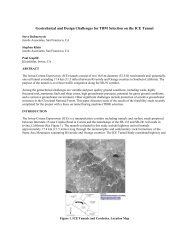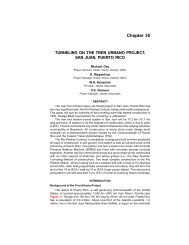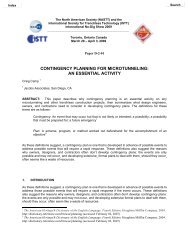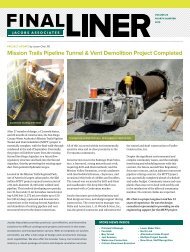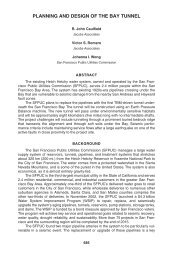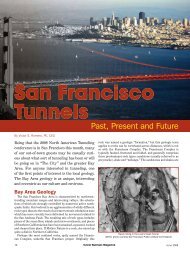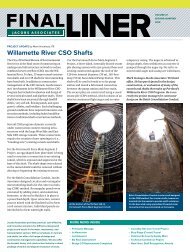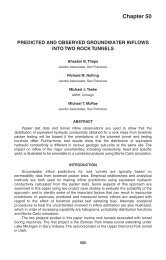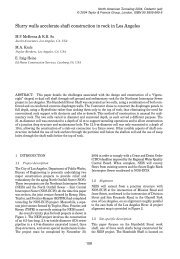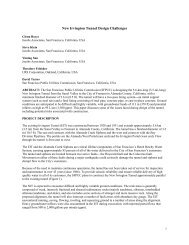Riverside Badlands Tunnel, Inland Feeder Project - Jacobs Associates
Riverside Badlands Tunnel, Inland Feeder Project - Jacobs Associates
Riverside Badlands Tunnel, Inland Feeder Project - Jacobs Associates
You also want an ePaper? Increase the reach of your titles
YUMPU automatically turns print PDFs into web optimized ePapers that Google loves.
1002 2003 RETC PROCEEDINGS<br />
<strong>Tunnel</strong>ing Challenges<br />
For the most part ground conditions encountered in the tunnel were as described<br />
in the GDSR. However, difficult conditions were encountered creating challenges that<br />
had to be overcome.<br />
Alluvial Valleys—San Timoteo and Live Oak Canyons. The tunnel had to cross<br />
two alluvial valleys at San Timoteo and Live Oak Canyons. The Contractor was<br />
required to design and implement appropriate groundwater control measures for<br />
mining through the saturated alluvium. Feasible approaches outlined in the GDSR<br />
included dewatering, use of an EPB tunneling machine, and jet grouting. Chemical<br />
grouting methods were considered to be only marginally applicable due to the cost and<br />
high fines content of the alluvium. SBB elected to dewater the alluvium and installed<br />
23 dewatering wells in San Timoteo Canyon and 10 wells in Live Oak Canyon. The<br />
wells were typically spaced 15 m (50 ft) apart alternating on each side of tunnel<br />
centerline and were designed to extend 3 to 7.5 m (10 to 25 ft) below tunnel invert.<br />
Dewatering started in San Timoteo Canyon (Reach 7) 8 weeks prior to the<br />
anticipated TBM arrival date. However, well yields were low and piezometer readings<br />
indicated that groundwater levels were not lowered sufficiently as they ranged from<br />
about 1.5 to 6 m (5 to 20 ft) above the tunnel crown when the TBM arrived at Reach 7.<br />
SBB considered that the ineffective dewatering was due to the ground having a lower<br />
permeability than expected, and decided that the ground could be controlled with the<br />
TBM by operating it in a partially pressurized mode (i.e. quasi-EPB) utilizing the screw<br />
conveyor. Unfortunately, the TBM was halted soon after entering the alluvium when<br />
silty sands flowed through the TBM and into the heading. At this point, it was obvious<br />
that tunneling could not proceed without a more positive means to control the flowing<br />
ground and SBB decided to chemically grout the rest of the alluvium in this tunnel<br />
reach. Drilling of vertical grout holes in a 3-hole pattern was initiated by as many as 5<br />
drill rigs. Holes were drilled on 2.1 m (7 ft) centers, and chemical grout (sodium<br />
silicate) was injected through sleeve port grout pipes in several stages to treat the<br />
tunnel zone. Within ten days of initiating the grouting work, mining resumed and the<br />
grouting production allowed mining to proceed on a single shift basis in which an<br />
average of 18 m (60 ft) of tunnel was excavated per day.<br />
While the chemical grouting operation in San Timoteo Canyon was successful, it<br />
was expensive and required complete surface access along the tunnel. Because<br />
similar ground conditions were anticipated ahead in Live Oak Canyon (Reach 5), and<br />
because the performance of SBB’s dewatering system in Reach 5 had also indicated<br />
insufficient dewatering, there was concern that chemical grouting might also be<br />
required in this canyon. However, conflicts with existing residences and nearby water<br />
wells created difficulties for a chemical grouting approach. In addition, experience<br />
gained from the installation of a new water well for one of the residents suggested that<br />
the permeability might be higher than originally anticipated in this canyon. Recognizing<br />
the constraints to grouting, the actual performance of SBB’s dewatering system, and<br />
the apparent higher permeability of the alluvium, SBB was directed to install two<br />
additional wells extending some 24 m (80 ft) below tunnel invert and into the San<br />
Timoteo Formation. These deeper wells produced an average flow of 14 L/sec<br />
(225 gpm) each and quickly lowered the groundwater level in the narrow canyon. By<br />
the time the TBM arrived at Reach 5, the groundwater level had been lowered to below<br />
the tunnel invert. As a result, mining proceeded through the alluvium in Reach 5<br />
without incident at an average rate of about 60 m/day (200 ft/day) [Table 4].<br />
Reach 4—San Timoteo Formation. North of Live Oak Canyon, in Reach 4, the<br />
groundwater level in the San Timoteo Formation gradually rises from about 15 m (50 ft)<br />
above the tunnel crown to over 60 m (200 ft) at a location several thousand feet north of<br />
the canyon. South of Live Oak Canyon, in Reach 6, the San Timoteo Formation was



